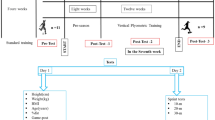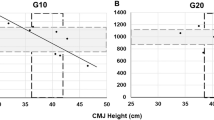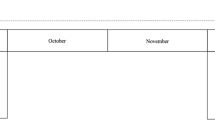Abstract
Purpose
During a soccer match, horizontal acceleration ability during short sprints is determinant for performance. Development of sprint force and velocity qualites have been reported after plyometric training. However, orientation of plyometric training exercises can influence the functional performance. The purpose of this study was to compare the horizontal and vertical orientation of plyometric training on explosiveness performances and sprint force–velocity profile in young soccer players.
Methods
Twenty-eight soccer players were recruited and divided in two groups: vertical (VG, n = 14) and horizontal (HG, n = 14) groups. Tests including jumps and sprint performances were conducted before and after the 8 week training period. Sprint force–velocity profile (FVP) was evaluated during a 30 m sprint test.
Results
The results demonstrated significant improvements in both VG and HG for jump performances (from + 4.9% to + 9.0%), sprint times (from −5.5% to −8.7%) and FVP parameters. Higher relative changes for the HG than for the VG were observed in 5 m and 15 m sprint times, horizontal jump lengths, and also in FVP parameters, especially improvements in maximal power (VG: + 16.4% vs. HG: + 28.1%) and in the decrease rate of horizontal orientation of force with increasing speed (HG: + 22.9%) during the 30 m sprint.
Conclusions
Both horizontal and vertical plyometric training can be either used in young soccer players to improve vertical and horizontal performances in jump and sprint. However, horizontal plyometric training may result in a greater improvement in horizontal ballistic actions while similarly developing vertical jump qualities compared to vertical plyometric training in young soccer players.


Similar content being viewed by others
Data availability
The data that support the findings of this study are available from the corresponding author upon reasonable request.
Abbreviations
- ANOVA:
-
Analyse of variance
- CMJ:
-
Counter movement jump
- CT:
-
Contact time
- CV:
-
Coefficient of variation
- DJ:
-
Drop jump from 30 cm
- DRF:
-
Slope of the force ratio—velocity relationship
- F0 :
-
Maximum force of the force–velocity modeling from 30 m linear sprint
- FVP:
-
Force–velocity profile
- HG:
-
Horizontal group
- MDC:
-
Minimal detectable change
- Pmax :
-
Theoretical maximum power
- RFmax :
-
Maximal ratio of force
- RSI:
-
Reactive strength index
- SJ:
-
Squat jump
- V0 :
-
Maximum velocity of the force–velocity modeling from 30 m linear sprint
- VG:
-
Vertical group
References
Avela J, Kyrolainen H, Komi PV, Rama D (1999) Reduced reflex sensitivity persists several days after long-lasting stretch-shortening cycle exercise. J Appl Physiol (1985) 86(4):1292–1300
Balsalobre-Fernandez C, Glaister M, Lockey RA (2015) The validity and reliability of an iPhone app for measuring vertical jump performance. J Sports Sci 33(15):1574–1579. https://doi.org/10.1080/02640414.2014.996184
Barrera-Dominguez FJ, Almagro BJ, Saez de Villarreal E, Molina-Lopez J (2023) Effect of individualised strength and plyometric training on the physical performance of basketball players. Eur J Sport Sci. https://doi.org/10.1080/17461391.2023.2238690
Burgess KE, Connick MJ, Graham-Smith P, Pearson SJ (2007) Plyometric vs. isometric training influences on tendon properties and muscle output. J Strength Cond Res 21(3):986–989. https://doi.org/10.1519/R-20235.1
Cazorla G, Ezzeddine-Boussaidi LB, Maillot J, Morlier J (2008) Physical qualities carried out on swerve sprint in team sports. Sci Sports 23:19–21. https://doi.org/10.1016/j.scispo.2007.11.002
Chelly MS, Hermassi S, Aouadi R, Shephard RJ (2014) Effects of 8-week in-season plyometric training on upper and lower limb performance of elite adolescent handball players. J Strength Cond Res 28(5):1401–1410. https://doi.org/10.1519/JSC.0000000000000279
Cohen J (1969) statistical power analysis for the behavioral sciences. Academic Press, New-York
Dello Iacono A, Martone D, Milic M, Padulo J (2017) Vertical- vs. horizontal-oriented drop jump training: chronic effects on explosive performances of elite handball players. J Strength Cond Res 31(4):921–931. https://doi.org/10.1519/JSC.0000000000001555
Ettema G (2024) The force-velocity profiling concept for sprint running is a dead end. Int J Sports Physiol Perform 19(1):88–91. https://doi.org/10.1123/ijspp.2023-0110
Faude O, Koch T, Meyer T (2012) Straight sprinting is the most frequent action in goal situations in professional football. J Sports Sci 30(7):625–631. https://doi.org/10.1080/02640414.2012.665940
Fernandez-Galvan LM, Boullosa D, Jimenez-Reyes P, Cuadrado-Penafiel V, Casado A (2021) Examination of the sprinting and jumping force-velocity profiles in young soccer players at different maturational stages. Int J Environ Res Public Health. https://doi.org/10.3390/ijerph18094646
Fouré A, Nordez A, Guette M, Cornu C (2009) Effects of plyometric training on passive stiffness of gastrocnemii and the musculo-articular complex of the ankle joint. Scand J Med Sci Sports 19(6):811–818. https://doi.org/10.1111/j.1600-0838.2008.00853.x
Fouré A, Nordez A, Cornu C (2010) Plyometric training effects on Achilles tendon stiffness and dissipative properties. J Appl Physiol 109(3):849–854. https://doi.org/10.1152/japplphysiol.01150.2009
Fouré A, Nordez A, McNair P, Cornu C (2011) Effects of plyometric training on both active and passive parts of the plantarflexors series elastic component stiffness of muscle-tendon complex. Eur J Appl Physiol 111(3):539–548. https://doi.org/10.1007/s00421-010-1667-4
Haynes T, Bishop C, Antrobus M, Brazier J (2019) The validity and reliability of the My Jump 2 app for measuring the reactive strength index and drop jump performance. J Sports Med Phys Fitness 59(2):253–258. https://doi.org/10.23736/S0022-4707.18.08195-1
Hug F, Turpin NA, Guevel A, Dorel S (2010) Is interindividual variability of EMG patterns in trained cyclists related to different muscle synergies? J Appl Physiol 108(6):1727–1736. https://doi.org/10.1152/japplphysiol.01305.2009
Jacobs R, van Ingen Schenau GJ (1992) Intermuscular coordination in a sprint push-off. J Biomech 25(9):953–965. https://doi.org/10.1016/0021-9290(92)90031-u
Keller S, Koob A, Corak D, von Schoning V, Born DP (2020) How to improve change-of-direction speed in junior team sport athletes-horizontal, vertical, maximal, or explosive strength training? J Strength Cond Res 34(2):473–482. https://doi.org/10.1519/JSC.0000000000002814
Loturco I, Pereira LA, Kobal R, Zanetti V, Kitamura K, Abad CC, Nakamura FY (2015) Transference effect of vertical and horizontal plyometrics on sprint performance of high-level U-20 soccer players. J Sports Sci 33(20):2182–2191. https://doi.org/10.1080/02640414.2015.1081394
Markovic G, Mikulic P (2010) Neuro-musculoskeletal and performance adaptations to lower-extremity plyometric training. Sports Med 40(10):859–895. https://doi.org/10.2165/11318370-000000000-00000
Mendez-Villanueva A, Buchheit M, Simpson B, Peltola E, Bourdon P (2011) Does on-field sprinting performance in young soccer players depend on how fast they can run or how fast they do run? J Strength Cond Res 25(9):2634–2638. https://doi.org/10.1519/JSC.0b013e318201c281
Moran J, Ramirez-Campillo R, Liew B, Chaabene H, Behm DG, Garcia-Hermoso A, Izquierdo M, Granacher U (2021) Effects of vertically and horizontally orientated plyometric training on physical performance: a meta-analytical comparison. Sports Med 51(1):65–79. https://doi.org/10.1007/s40279-020-01340-6
Morin JB, Samozino P (2016) interpreting power-force-velocity profiles for individualized and specific training. Int J Sports Physiol Perform 11(2):267–272. https://doi.org/10.1123/ijspp.2015-0638
Ramirez-Campillo R, Meylan C, Alvarez C, Henriquez-Olguin C, Martinez C, Canas-Jamett R, Andrade DC, Izquierdo M (2014) Effects of in-season low-volume high-intensity plyometric training on explosive actions and endurance of young soccer players. J Strength Cond Res 28(5):1335–1342. https://doi.org/10.1519/JSC.0000000000000284
Ramirez-Campillo R, Gallardo F, Henriquez-Olguin C, Meylan CM, Martinez C, Alvarez C, Caniuqueo A, Cadore EL, Izquierdo M (2015) Effect of vertical, horizontal, and combined plyometric training on explosive, balance, and endurance performance of young soccer players. J Strength Cond Res 29(7):1784–1795. https://doi.org/10.1519/JSC.0000000000000827
Rodriguez Fernandez A, Sanchez J, Rodriguez Marroyo JA, Villa JG (2016) Effects of seven weeks of static hamstring stretching on flexibility and sprint performance in young soccer players according to their playing position. J Sports Med Phys Fitness 56(4):345–351
Romero-Franco N, Jimenez-Reyes P, Castano-Zambudio A, Capelo-Ramirez F, Rodriguez-Juan JJ, Gonzalez-Hernandez J, Toscano-Bendala FJ, Cuadrado-Penafiel V, Balsalobre-Fernandez C (2017) Sprint performance and mechanical outputs computed with an iPhone app: comparison with existing reference methods. Eur J Sport Sci 17(4):386–392. https://doi.org/10.1080/17461391.2016.1249031
Saez de Villarreal E, Requena B, Cronin JB (2012) The effects of plyometric training on sprint performance: a meta-analysis. J Strength Cond Res 26(2):575–584. https://doi.org/10.1519/JSC.0b013e318220fd03
Samozino P, Peyrot N, Edouard P, Nagahara R, Jimenez-Reyes P, Vanwanseele B, Morin JB (2022) Optimal mechanical force-velocity profile for sprint acceleration performance. Scand J Med Sci Sports 32(3):559–575. https://doi.org/10.1111/sms.14097
Spurrs RW, Murphy AJ, Watsford ML (2003) The effect of plyometric training on distance running performance. Eur J Appl Physiol 89(1):1–7. https://doi.org/10.1007/s00421-002-0741-y
Vigne G, Gaudino C, Rogowski I, Alloatti G, Hautier C (2010) Activity profile in elite Italian soccer team. Int J Sports Med 31(5):304–310. https://doi.org/10.1055/s-0030-1248320
von Lieres Und Wilkau HC, Bezodis NE, Morin JB, Irwin G, Simpson S, Bezodis IN, (2020) The importance of duration and magnitude of force application to sprint performance during the initial acceleration, transition and maximal velocity phases. J Sports Sci 38(20):2359–2366. https://doi.org/10.1080/02640414.2020.1785193
Watkins CM, Gill ND, Maunder E, Downes P, Young JD, McGuigan MR, Storey AG (2021) The effect of low-volume preseason plyometric training on force-velocity profiles in semiprofessional rugby union players. J Strength Cond Res 35(3):604–615. https://doi.org/10.1519/JSC.0000000000003917
Wilson JM, Flanagan EP (2008) The role of elastic energy in activities with high force and power requirements: a brief review. J Strength Cond Res 22(5):1705–1715. https://doi.org/10.1519/JSC.0b013e31817ae4a7
Wu YK, Lien YH, Lin KH, Shih TT, Wang TG, Wang HK (2010) Relationships between three potentiation effects of plyometric training and performance. Scand J Med Sci Sports 20(1):e80-86. https://doi.org/10.1111/j.1600-0838.2009.00908.x
Young WB (2006) Transfer of strength and power training to sports performance. Int J Sports Physiol Perform 1(2):74–83. https://doi.org/10.1123/ijspp.1.2.74
Zhang Q, Pommerell F, Owen A, Trama R, Martin C, Hautier CA (2021) Running patterns and force-velocity sprinting profiles in elite training young soccer players: a cross-sectional study. Eur J Sport Sci. https://doi.org/10.1080/17461391.2020.1866078
Acknowledgements
The authors thank all the participants who participated to the present study.
Author information
Authors and Affiliations
Contributions
F.N. and A.F. contributed to the conception and the design of the study; F.N. and A.F. contributed to the literature review; F.N. contributed to the collection of the data; F.N. and A.F. contributed to the data analysis and interpretation; F.N. and A.F. contributed to the statistical analyses, F.N. and A.F. have written the manuscript and reviewed/edited a draft of the manuscript.
Corresponding author
Ethics declarations
Conflict of interest
The authors declare no conflict of interest, financial or otherwise.
Ethical approval
The study was conducted in conformity with the last version of the Declaration of Helsinki and has been approved by the local ethics committee.
Consent to participate
Informed consent was obtained from all individual participants included in the study.
Additional information
Communicated by Olivier Seynnes.
Publisher's Note
Springer Nature remains neutral with regard to jurisdictional claims in published maps and institutional affiliations.
Rights and permissions
Springer Nature or its licensor (e.g. a society or other partner) holds exclusive rights to this article under a publishing agreement with the author(s) or other rightsholder(s); author self-archiving of the accepted manuscript version of this article is solely governed by the terms of such publishing agreement and applicable law.
About this article
Cite this article
Norgeot, F., Fouré, A. Effects of vertical and horizontal plyometric training on jump performances and sprint force–velocity profile in young elite soccer players. Eur J Appl Physiol (2024). https://doi.org/10.1007/s00421-024-05477-4
Received:
Accepted:
Published:
DOI: https://doi.org/10.1007/s00421-024-05477-4




